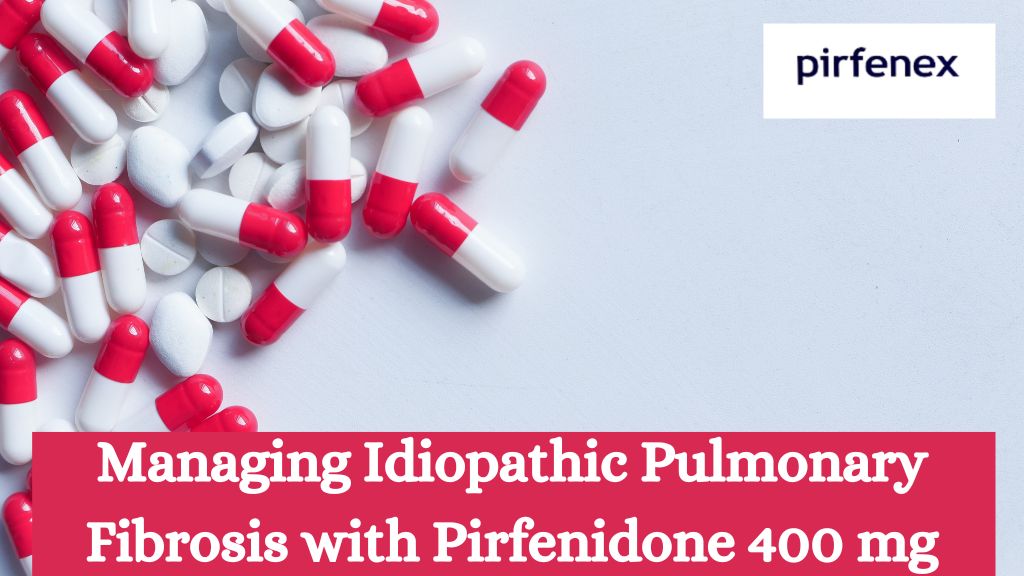
Idiopathic Pulmonary Fibrosis (IPF) is a chronic and progressive lung disease that affects millions of people worldwide. Characterized by the scarring and thickening of lung tissues, IPF makes breathing increasingly difficult over time. Fortunately, medical advancements have led to treatments that can help manage the condition and improve patients’ quality of life. One such treatment is Pirfenidone 400 mg, a medication that has shown promise in slowing down the progression of IPF. In this comprehensive guide, we will delve into the details of managing Idiopathic Pulmonary Fibrosis with Pirfenidone 400 mg.
What is IPF?
Idiopathic Pulmonary Fibrosis is a chronic lung disorder characterized by the gradual scarring of lung tissues. The exact cause of IPF remains unknown, which is why it’s referred to as “idiopathic.” Over time, the scar tissue thickens and stiffens the lungs, making it increasingly difficult for the patient to breathe.
Causes and Risk Factors
While the exact cause is uncertain, certain factors increase the risk of developing IPF. These may include a history of smoking, genetics, exposure to environmental pollutants, and age. However, IPF can affect individuals without any obvious risk factors as well.
Symptoms and Diagnosis
The symptoms of IPF often develop gradually and include shortness of breath, dry and persistent cough, fatigue, and unexplained weight loss. Diagnosing IPF involves a combination of medical history, physical examinations, lung function tests, and imaging studies like high-resolution CT scans.
Pirfenidone is an antifibrotic medication that targets the underlying mechanisms of IPF. It helps reduce the production of fibrous tissue in the lungs and inhibits the progression of scarring. By slowing down this fibrotic process, Pirfenidone can potentially improve lung function and delay disease progression.
Benefits and Expected Outcomes
Clinical trials have shown that Pirfenidone can slow down the decline in lung function, decrease the risk of acute exacerbations, and improve patients’ overall quality of life. It’s important to note that individual responses to the medication may vary.
Administration and Dosage
Pirfenidone is typically taken orally in the form of Pirfenidone 400 mg capsules. The dosage and administration instructions are provided by the healthcare provider based on the patient’s condition and tolerance. Adhering to the prescribed dosage is crucial for optimal results.
Consultation with a Healthcare Provider
If you or a loved one has been diagnosed with IPF, it’s essential to consult a healthcare provider specializing in lung diseases. They will evaluate the patient’s medical history, conduct tests, and determine if Pirfenidone is a suitable treatment option.
Precautions and Considerations
Before starting Pirfenidone, inform your healthcare provider about any existing medical conditions, allergies, or medications you’re taking. It’s important to have an open dialogue to ensure the medication’s safety and effectiveness.
Creating a Treatment Plan
Once Pirfenidone is deemed appropriate, the healthcare provider will work with the patient to create a personalized treatment plan. This plan will include the dosage, administration schedule, and regular follow-up appointments to monitor progress and address any concerns.
Common Side Effects
Like any medication, Pirfenidone may cause side effects. Common ones include nausea, fatigue, rash, and gastrointestinal discomfort. Most side effects are manageable and tend to improve as the body adjusts to the medication.
Monitoring and Managing Side Effects
Patients should communicate openly with their healthcare provider about any side effects experienced. The healthcare team can offer guidance on managing side effects and adjusting the treatment plan if necessary.
When to Seek Medical Help
While most side effects are mild, some may require immediate medical attention. These include severe allergic reactions, chest pain, breathing difficulties, and signs of liver problems. If any unusual symptoms occur, contact a healthcare provider promptly.
Importance of Exercise
Engaging in regular physical activity can help improve lung function, strengthen muscles, and enhance overall well-being. Consult the healthcare provider before starting an exercise regimen to ensure it’s safe and appropriate for the patient’s condition.
Balanced Diet and Hydration
A nutritious diet rich in vitamins and minerals can support the immune system and promote healing. Staying hydrated is also crucial for maintaining optimal lung function.
Breathing Techniques and Pulmonary Rehabilitation
Patients can benefit from learning breathing techniques that help manage shortness of breath. Pulmonary rehabilitation programs, supervised by professionals, provide exercises and strategies to enhance lung capacity.
Building a Support Network
Living with a chronic lung condition can be emotionally challenging. Building a support network of family, friends, and healthcare professionals can provide comfort, encouragement, and understanding.
Mental Health and Coping Strategies
It’s common for individuals with IPF to experience anxiety, depression, or stress. Seeking professional help from therapists or counselors can provide effective coping strategies and improve emotional well-being.
Joining Support Groups
Joining support groups or online communities for IPF patients and caregivers can provide a sense of belonging and a platform to share experiences, tips, and advice.
Regular Check-ups and Monitoring
Regular follow-up appointments with the healthcare provider are essential to monitor the progress of the treatment and assess any changes in lung function. Adjustments to the treatment plan may be made based on these evaluations.
Treatment Adjustments and Modifications
Over time, the healthcare provider may recommend adjustments to the dosage or treatment approach to ensure the best possible outcome for the patient. Open communication about progress and concerns is crucial.
Disease Progression and Future Outlook
IPF is a progressive disease, and while Pirfenidone can slow its progression, it’s important to be prepared for potential challenges. Regular check-ups and adherence to the treatment plan can contribute to better disease management.
Real-life Experiences with Pirfenidone
Hearing about others’ experiences with Pirfenidone can offer hope and inspiration. Many patients have reported improved lung function, increased energy levels, and a better quality of life.
Overcoming Challenges and Celebrating Progress
Managing IPF requires resilience and determination. Celebrating even small victories along the way can boost morale and provide motivation to continue the journey.
WhatsApp us